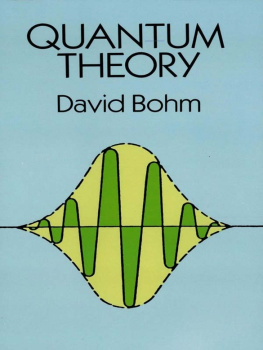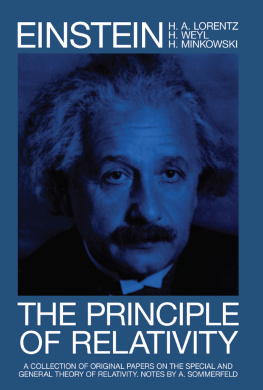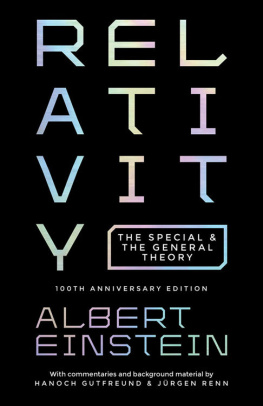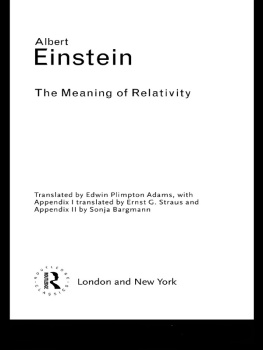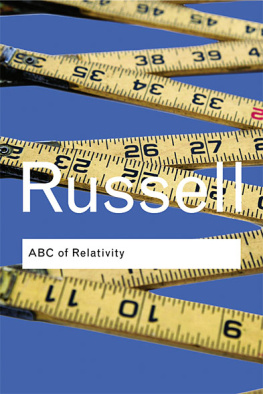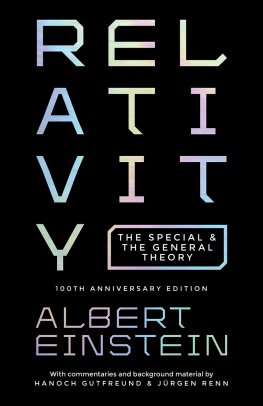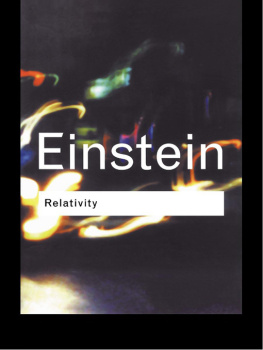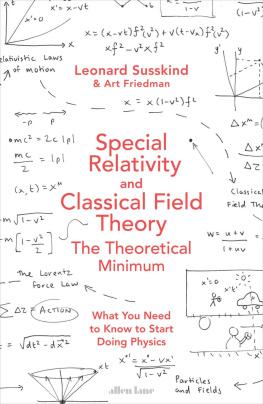The Special Theory of Relativity
Bohm presents a highly original view of what it means to look at the world with new eyes.
Journal of Consciousness Studies
Bohms creative work in physics is undisputable.
Skeptical Inquirer

Routledge Classics contains the very best of Routledge publishing over the past century or so, books that have, by popular consent, become established as classics in their field. Drawing on a fantastic heritage of innovative writing published by Routledge and its associated imprints, this series makes available in attractive, affordable form some of the most important works of modern times.
For a complete list of titles visit
www.routledge.com/classics
David
Bohm
The Special Theory
of Relativity
With a foreword by Basil Hiley
and a new preface by John D.Barrow

First published 1965 by W. A. Benjamin, Inc.
First published 1996 by Routledge
First published in Routledge Classics 2006
by Routledge
2 Park Square, Milton Park, Abingdon, Oxon OX14 4RN
Simultaneously published in the USA and Canada
by Routledge
711 Third Avenue, New York, NY 10017
Routledge is an imprint of the Taylor & Francis Group, an informa business
1965, 1996 Sarah Bohm
Foreword 1996 B. J. Hiley
Preface to the Routledge Classics edition 2006 John D. Barrow
All rights reserved. No part of this book may be reprinted or reproduced or utilized in any form or by any electronic, mechanical, or other means, now known or hereafter invented, including photocopying and recording, or in any information storage or retrieval system, without permission in writing from the publishers.
British Library Cataloguing in Publication Data
A catalogue record for this book is available from the British Library
Library of Congress Cataloging in Publication Data
Bohm, David.
The special theory of relativity / David Bohm ; with a foreword by Basil Hiley and a new preface by John Barrow.
p. cm.(Routledge classics)
Originally published: New York : W.A. Benjamin, 1965.
Includes bibliographical references and index.
ISBN 0415404258
1. Special relativity (Physics) I. Title. II. Series.
QC173.65.B64 2006
530.11dc22 2006017434
ISBN10: 0415404258
ISBN13: 9780415404259
C ONTENTS
F OREWORD
The final year undergraduate lectures on theoretical physics given by David Bohm at Birkbeck College were unique and inspiring. As they were attended by experimentalists and theoreticians, the lectures were not aimed at turning out students with a high level of manipulative skill in mathematics, but at exploring the conceptual structure and physical ideas that lay behind our theories. His lectures on special relativity form the content of this book.
This is not just another text on the subject. It goes deeply into the conceptual changes needed to make the transition from the classical world to the world of relativity. In order to appreciate the full nature of these radical changes, Bohm provides a unique appendix entitled Physics and Perception in which he shows how many of our self-evident notions of space and of time are, in fact, far from obvious and are actually learnt from experience. In this appendix he discusses how we develop our notions of space and of time in childhood, freely using the work of Jean Piaget, whose experiments pioneered our understanding of how children develop concepts in the first place.
Bohm also shows how, through perception and our activity in space, we become aware of the importance of the notion of relationship and the order in these relationships. Through the synthesis of these relationships, we abstract the notion of an object as an invariant feature within this activity which ultimately we assume to be permanent. It is through the relationship between objects that we arrive at our classical notion of space. Initially, these relations are essentially topological but eventually we begin to understand the importance of measure and the need to map the relationships of these objects on to a co-ordinate grid with time playing a unique role. His lucid account of how we arrive at our classical notions of space and absolute time is fascinating and forms the platform for the subsequent development of Einsteins relativity.
After presenting the difficulties with Newtonian mechanics and Maxwells electrodynamics, he shows how the Michelson Morley experiment can be understood in terms of a substantive view of the ether provided by Lorentz and Fitzgerald. The difficulties in this approach, which assumes actual contraction of material rods as they move through the ether, are discussed before a masterful account of Einsteins conception of space-time is presented. Bohms clarity on this topic was no doubt helped by the many discussions he had with Einstein in his days at Princeton.
The principle of relativity is presented in terms of the notion of relationship and the order of relationship that were developed in the appendix and he argues that a general law of physics is merely a statement that certain relationships are invariant to the way we observe them. The application of this idea to observers in relative uniform motion immediately produces the Lorentz transformation and the laws of special relativity.
Interlaced with the chapters on the application of the Lorentz transformation, is a chapter on the general notion of the falsification of theories. Here he argues against the Popperian tradition that all that matters is mere experimental falsification. Although a preliminary explanation might fit the empirical data, it may ultimately lead to confusion and ambiguity and it is this that could also lead to its downfall and eventual abandonment in favour of another theory even though it contradicts no experiment. His final chapters on time and the twin paradox exhibit the clarity that runs throughout the book and makes this a unique presentation of special relativity.
B. J. H ILEY
P REFACE TO THE R OUTLEDGE C LASSICS E DITION
There has been no greater scientific celebrity than Albert Einstein. In 2005, the world of physics celebrated Einstein Year to mark the centenary of his trio of great discoveries. Publicists must despair that he could achieve such status in the pre-TV era, without an agent or the help of a public relations company. He didnt even have a website. And I doubt that more than a handful of us have seen him on film or heard his voice. Yet his face has become an icon for wisdom, imagination, creativity, and concentrated mental power, while his name is an enduring synonym for genius. How did all this come about? The answer is simply the theory of relativity.
Relativity was a fashionable philosophical notion at the start of the twentieth century. It sounded as if it could sweep away old prejudices and refurnish science with modern ideas. There were revolutions in art and literature. In such a climate Einsteins relativity resonated with the world beyond the physics laboratory. Nobody ever got excited about his great papers on Brownian motion and the photoelectric effect, but relativity promised to turn the world inside out. The fact that it was supposedly understood by only a handful of people on the planet was both a comfort and added cachet. Its legendary difficulty excused you from understanding it or even trying to. Especially appealing to the outsider was the fact that Einsteins ideas about space and time used familiar words like mass and energy but endowed them with new and richer meanings. Everyone knew what these words meant even though sentences like everything is relative or moving clocks go slow dont by themselves convey any useful information at all.
Next page

